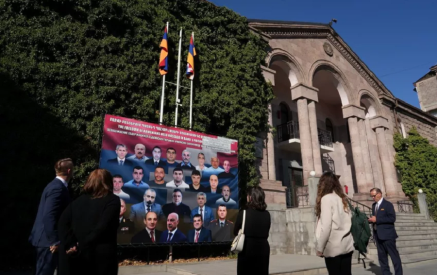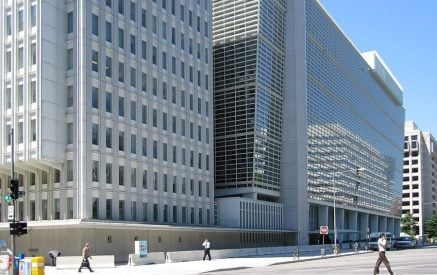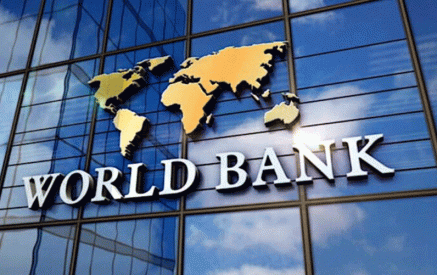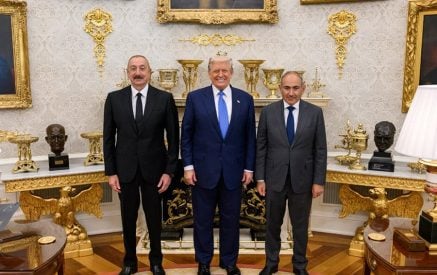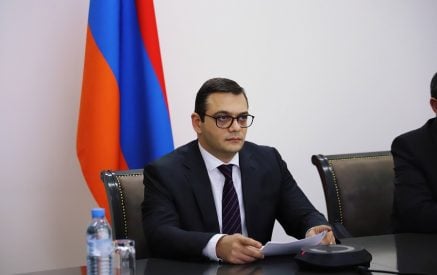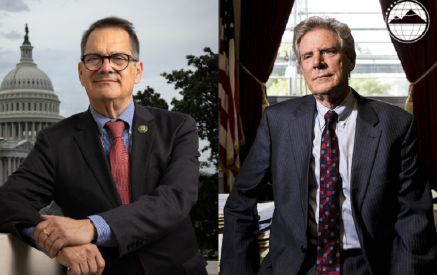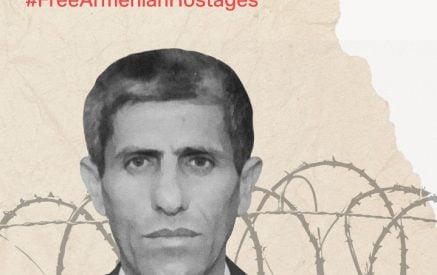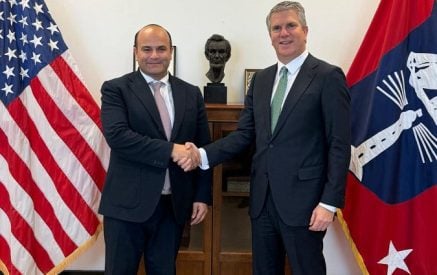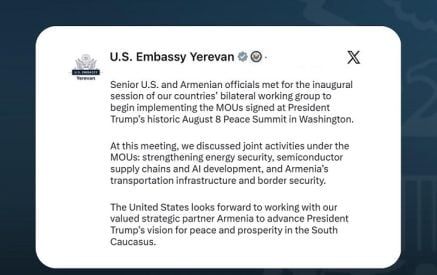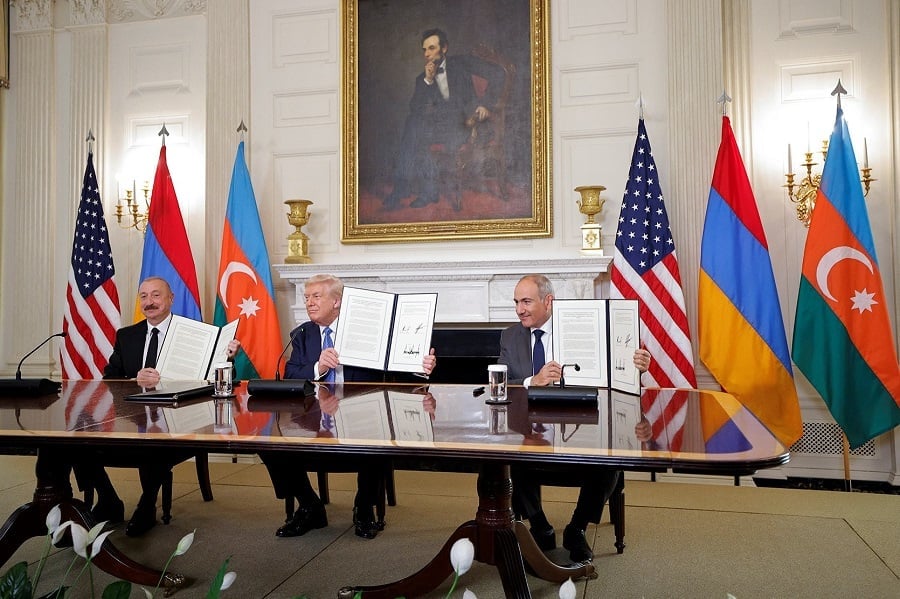The Armenian Mirror-Spectator. In the wake of the August 8 agreement signing in Washington, Armenian Prime Minister Nikol Pashinyan remains as complacent as ever. He claims to have obtained guarantees of peace and sovereignty. However, the facts seem to point to the opposite: Armenia’s loss of sovereignty over part of its territory, shifting alliances with incalculable economic and military consequences, and a complete lack of clearly-identified gains for Armenia.
The American solution aims to isolate Russia and Iran, an objective that satisfies both the Europeans and Israel. But the Europeans should be concerned with regard to repercussions in the geoeconomic and geopolitical spheres; the Central Asia-Europe trade they were considering in the Samarkand Agreement signed in April 2025, in particular to obtain hydrocarbon supplies and free themselves from dependence on Russian gas and oil, will, go under US control, if the Washington Agreement comes to fruition. An added warning sign for Europe is that an EXXON-SOCAR (Azerbaijan’s national gas company) agreement was signed in Washington on the sidelines of the Aliyev-Trump meeting.
One has to search in vain for measures benefiting Armenia in this accord — one can go further and say there are, in fact, none. On the contrary, this agreement weakens Armenia’s national security and undermines its sovereignty over part of the territory. The Armenian government and Pashinyan’s supporters may try their best to pretend otherwise, but the facts are indisputable. Ironically Aliyev even obtained the release of American military aid to Azerbaijan hitherto forbidden under Freedom Section 907) even though he came to sign a so-called framework agreement for peace and reconciliation. Armenia made no demands in this area. In short, instead of the peace desired by the Pashinyan government at the cost of heavy and incessant unilateral concessions, all the seeds of a future war are in place.
The presence of a private American company providing security on the Trump Road for Peace and Prosperity (TRIPP) will not change anything. It will only be there to secure the energy, road, rail, and digital transport infrastructures, but not the rest of Armenian territory. One cannot rely upon the United States to defend Armenia militarily in case of an attack.
Read also
The best illustration of the situation is that of the Syrian oil wells, which have been controlled and protected by the American army since 2014. While war has continued to rage on the Syrian territory to this day, including Israeli and Turkish incursions and bombardments of the territory and the overthrow of President Assad, at no time has the United States intervened directly in the armed conflicts: the protection of American oil companies exploiting the wells is their sole mission as if this portion of the territory and its mineral resources does not belong anymore to Syria. The Armenian population must be aware of this and not imagine another outcome.
Pashinyan’s smile cannot obscure the fact that Azerbaijan is triumphant on all counts and even reserves the right to sign the “peace treaty” when its other preliminary conditions are met: the first is expressed immediately, it concerns the amendment of the Armenian Constitution in connection with the mention of the annexation of Nagorno-Karabakh. The second cannot be long in coming: it concerns the return of Azerbaijanis born in Armenia who left it in the early 1990s. The Declaration of the Azerbaijani Ministry of Foreign Affairs is subtle enough not to mention this last point so as not to spoil the Trumpian jubilation.
Let’s analyze the Declaration, its geopolitical consequences and its constitutionality as per the Armenian Constitution.
I – What Does the Text Say?
The official text is ambiguous on many points but revealing on others.
Item 1 simply notes that not all the conditions for signing a peace agreement have been met and that further action is necessary. This corroborates Aliyev’s comments.
Item 2 notes that both parties have signed a request to dissolve the Organization for Security and Cooperation in Europe (OSCE) Minsk Group. Both countries call on other OSCE’s participating states to make such a request. The OSCE Secretary General (a Turkish diplomat) reacted quickly and very diplomatically, stating that his organization “was ready to implement the provisions of this declaration” but that their commitment remains to establish a lasting peace.
Item 3 reaffirms the importance of opening communications between the two countries for intrastate, bilateral and international transport while respecting the sovereignty, territorial integrity and jurisdiction of states. The Armenian Prime Minister considers this phrase to be a firm commitment by Azerbaijan to respect the sovereignty of Armenia. However, Pashinyan’s comments of the Declaration clearly demonstrate the ambiguity and fragility of the initialed text. There is no concrete, fixed commitment and Pashinyan himself states that “the document does not contain technical details” and emphasizes that “all future solutions must respect the principles of sovereignty, territorial integrity, and jurisdiction of states.” In short, nothing is defined nor guaranteed.
It is only specified, but without clear explanation, that efforts will be aimed at ensuring “unhindered connectivity between the main part of the Republic of Azerbaijan and the Nakhichevan Autonomous Republic through the territory of the Republic of Armenia.” What does “unhindered connectivity” mean? Flow of goods without transit fees and control? Flow of persons without any control? In return, the text does not mention or define specific connectivity for Armenia. It evokes vaguely “mutual benefits for the international and intrastate connectivity of the Republic of Armenia.” How can direct connectivity between Iran and Armenia be ensured if a strip of land controlled by a private American company stands in its way?
Item 4 is by far the most harmful because it directly affects sovereignty. Indeed, it grants Azerbaijan the right to “mutually determine third parties” who will work with the Republic of Armenia and the United States of America “to set forth a framework for the Trump Route for International Peace and Prosperity (TRIPP) connectivity project in the territory of the Republic of Armenia.” In other words, Azerbaijan has decision-making power over the connectivity model that will be implemented and the third party that will manage it over the territory of Armenia. Sovereignty? Azerbaijani diplomacy interprets this text as a necessity to ensure “unhindered connectivity” between the main part of Azerbaijan and its autonomous Republic of Nakhichevan. It therefore sets its conditions even before the establishment of the announced working group.
Under these conditions, Azerbaijan does not hesitate to sign items 5 and 6 to affirm its desire to put aside the past and the spirit of revenge and, instead, to build bilateral relations based on trust and mutual respect.
It should be recalled that at no point does this declaration define the benefits for Armenia, and it is completely silent on the right of return of the Armenians of Artsakh, the release of Armenian hostages detained and tried by Baku, or the protection of the Armenian cultural heritage of Artsakh. The absence of any reference to these last points testifies to Azerbaijan’s triumph and Armenia’s formal capitulation on this issue, but also on the issue concerning the part of “real Armenia” territory that is still occupied.
II – Geopolitical Consequences
The reactions of third-party states are enigmatic and one of embarrassment. The Armenian Prime Minister and the Armenian Ministry of Foreign Affairs are actively trying to inform those states while downplaying the risks related to the content of the signed agreement.
Iran’s reactions vary depending on the interlocutor. The Iranian president, a supporter of dialogue with the United States, welcomed the agreement and maintained that Iran’s wishes to preserve its communication routes to the North have been taken into account. The Armenian Prime Minister asserted that a rail connection with Iran is planned. At this stage of the matter, there is no evidence to support the statements of the two leaders. The softened tone of the Iranian reaction, however, reflects Iran’s weakened state. The Iranian president expressed “concern that an American-Armenian company is building this road” near to the Armenian-Iranian border.
Russia cannot have failed to be informed of the content of this agreement by Armenia before the meeting in Washington. The diplomatic channels between Russia and Armenia are still vigorous. Thus, the question of Russian strategy remains unanswered: has Russia sacrificed its interests in the Caucasus, and in particular its relationship with Iran, to ensure a better balance of power in the upcoming negotiations on Ukraine with President Trump? Or is it buying time to derail this project by other means? In the absence of information, I will not risk speculating on these questions. However, the statement by the Russian Foreign Ministry spokesperson gives one pause. Russia emphasizes that “the trilateral agreements concluded by Moscow with the two South Caucasus countries remain valid,” said Maria Zakharova. She added that neither Armenia nor Azerbaijan had officially withdrawn from the 2020 agreement brokered by Moscow to end the six-week war in Nagorno-Karabakh, which included a provision for regional connectivity with Russian participation. Finally, she referred to the 1995 Russian-Armenian bilateral agreements (renewed in 2010) that assign the protection of Armenia’s borders with Turkey and Iran to Russian border guards. How will this border protection fit with the protection of the “unimpeded communication route” by a US controlled corporation? It will be necessary to await the outcome of the Trump-Putin meeting to clarify this Russian stance.
President Putin and the Armenian Prime Minister held talks in preparation for the Trump-Putin summit in Alaska.
The European Union welcomed this agreement, but its statement likely conceals their disappointment. The Samarkand Agreement provided for European investments in Central Asia in the fields of transport, strategic minerals and energy, in response to the customs tariffs imposed by the United States. The latter has just inflicted a potential coup de grace to necessary Central Asian minerals sought by Europe.
France welcomes the agreement and unwaveringly aligns itself with Washington and its leadership role. President Macron’s Atlanticist approach is nothing new. But France claims with great fanfare to be Armenia’s main protector and Pashinyan’s unwavering supporter. Aren’t the French efforts focused on Syunik threatened by this potentially US-controlled communication channel? This agreement can only create unease in France.
There is also a hidden side that has not yet been revealed in this theatre. France has been working discreetly for some time to bring Turkey and Armenia closer together, and the success of the Washington agreement could also be explained by this as there is a convergence of views to Turkey’s great benefit.
Turkey, which has remained on the sidelines in this affair, is the big winner, along with Azerbaijan and the United States. Turkey and Israel are Trump’s two strategic partners in the Caucasus and the Middle East. Both states get their way: the former gains access to Central Asia; the latter secures the encirclement of Iran.
So, exit France and the European Union.
Exit Iran too, as well as India and China. Those three countries will not welcome American control in this region because this communication corridor cuts off their economic route to Russia and opens the door to a rapprochement between the Turkic and Muslim states of Europe and those of Central Asia — a Turkic-Muslim influence that they so fear.
Through this impromptu agreement (even though the solution of a private American company had been discussed for a year in insider circles in Yerevan, before Trump’s arrival as president), the Armenian government has therefore sacrificed all the so-called strategic relationships it has strived to build over the past two years with Iran, India and China. It must be recalled that Armenia has very little trade with the West: export trade with Europe and the United States is insignificant at 8.4 percent, while trade with Russia represents 39 percent and trade with regional countries (Iran, Georgia, India, China) represents 41 percent. The East-West route serves only Turkish, American, and European interests.
In short, the circumstantial postures of Russia and Iran, and the likely reluctance of India and China, herald a difficult future for the Washington Agreement and for Armenia’s diplomacy and economy.
III – The Consequences at Domestic Political Level
Prime Minister Pashinyan, his Minister of Foreign Affairs, and the lieutenants of the “Civil Contract” party will nevertheless strive in the days and weeks to convince their supporters, who are dwindling in number (a recent poll shows only 12 percent trust Pashinyan), that Azerbaijan is committed to respecting peace and that Armenia’s sovereignty is not being undermined. The propaganda machine will be put in place, and the takeover of all levers of power will be secured in order to be able to pass agreements that contradict the Constitution and harm national interests.
Following the takeover of the judiciary and of the Constitutional Court in 2020, the attempted control over the Armenian Apostolic Church and the diaspora communities, the economic pressure exerted on refugees from Artsakh, the arrest of opposition party members, and the neutralization of popular figures such as Samvel Karapetyan and Ruben Vardanyan, philanthropists and investors, the next target will be the press. The newspaper Aravot is being evicted from its historic building. It will therefore be important to monitor the fate of independent media, the only power not to have come under the Prime Minister’s sole control. It should be noted that President Trump’s praise for President Aliyev’s longevity and effectiveness can only encourage the Armenian Prime Minister to strengthen his absolute power, assured that he will have the support of both Trump and Aliyev. The Prime Minister’s goal is to remain in power at all costs in 2026 in order to pass the constitutional reform that would confirm the promises made to Azerbaijan.
Indeed, the Washington agreement is unconstitutional. It should be remembered that the Constitution of the Republic of Armenia was adopted by the people in 1995 based on the founding principles of the Armenian statehood and on its national objectives as defined in the Declaration of Independence of Armenia, adopted on August 23, 1990. Those national objectives include the reunification of Armenia and Artsakh but also the struggle for historical injustices.
Which institutions may oppose this anti-national project? The National Assembly is controlled by two-thirds of the Prime Minister’s party, and the Constitutional Court is composed mostly of judges appointed by the Prime Minister and highly remunerated. The opposition parties have still not created the conditions for impeachment and for a political change acceptable to the population.
The ruling power and its supporters will argue that there is no possible alternative to the Washington Agreement. This is fundamentally false. Even if it were fair, the method is disastrous because there is no negotiation and the strategic thinking is summed up by a simplistic and naive slogan: “crossroads of peace.”
As stated, the peace treaty will not be signed until all Azerbaijani demands are met. Establishing a communication route facilitating East-West trade will not be enough to guarantee a lasting and viable peace. On the contrary, it is a potential source of tension and even of regional conflict.
IV – The Conditions for Peace Are Not Met
Throughout history, the world has witnessed numerous attempts at peace through agreements or treaties. These diplomatic efforts, born out of a sincere desire to end hostilities and promote stability, aimed to resolve conflicts ranging from territorial disputes to ideological differences. While some peace agreements have established lasting peace (mainly in Europe), others have encountered significant difficulties, ultimately proving unsuccessful. These include: The Minsk Agreements (2014-2015), which aimed to de-escalate the war in Donbass (Ukraine); the 2020 Doha Agreement (United States and the Taliban), which aimed to end the war in Afghanistan. The agreement explicitly limited US military action and that contributed to the collapse of the Afghan government; The Oslo Accords (1993-1995) between Israel and the PLO, whose current status is notoriously grim; various peace agreements in Colombia since 1953; and the Angolan Peace Accords (1991, 1994).
The main factors in the failure of these agreements are the lack of guarantees for lasting peace, in particular:
- The lack of strong enforcement mechanisms. Without a credible third party or sufficient incentives to respect commitments, the parties risk reneging on their commitments. The elimination of the OSCE Minsk Group is a bad omen in that respect.
- The failure to address root causes: Treaties that focus solely on ending hostilities without addressing underlying political, economic or social grievances are unlikely to endure. It is worth recalling that Azerbaijan has not ceased its policy of hatred and racial discrimination against Armenians. Withdrawal from proceedings before the International Court of Justice is a major historical mistake for Armenia.
- Insufficient inclusion of all stakeholders. First, it is worth noting the exclusion of a key group: the population of Nagorno-Karabakh, the primary victim of war, which is also the reason why a peace treaty is being discussed. However, both Azerbaijan’s responsibility and the issue of reparation, namely the right of return, are completely ignored. Second, there is a lack of information and involvement of Armenian civil society. Society discovers the content of the agreements at the time of their signing without having taken part to any debate or democratic approval while national interests — national security and the country’s sovereignty — are at stake. Third, there are Armenian nationals held hostage in Azerbaijan, of whom no mention is made in these agreements. These exclusions can only breed resentment, a lack of legitimacy, and possibly a subsequent challenge to the agreement.
- The presence of ambiguous or ill-defined terms: Vague language can lead to conflicting interpretations and disputes during implementation. Some of these ambiguities are analyzed above.
Regarding the method, the outcome of all the agreements announced by the Armenian side for some time has indicated that there is no negotiation. One side imposes its claims on the other and the other capitulates. Azerbaijan is clearly pursuing a conquering strategic objective, while the Pashinyan’s approach is solely aimed at keeping power and not at pursuing national interests, since he bluntly rejected the concept of nation preferring instead the concept of “real Armenia”.
Every step taken by the Prime Minister works against Armenia’s interests. It will always be possible to cancel some of the agreements, but the more time passes, the more the chances of reversing them peacefully diminish or disappear. Washington agreement or not, the “real Armenia,” which is shrinking at every step of this uncontrolled process, still does not know whether its immediate future will be peace or war, prosperity or economic debacle. This is all it takes for a disillusioned Armenian population to pack its bags.
Philippe Raffi Kalfayan,
based in Paris, is a lawyer, lecturer in international law and a former secretary general of FIDH (International Federation of Human Rights), who has earned a Ph.D. in international law. He is a regular columnist for the Armenian Mirror-Spectator


